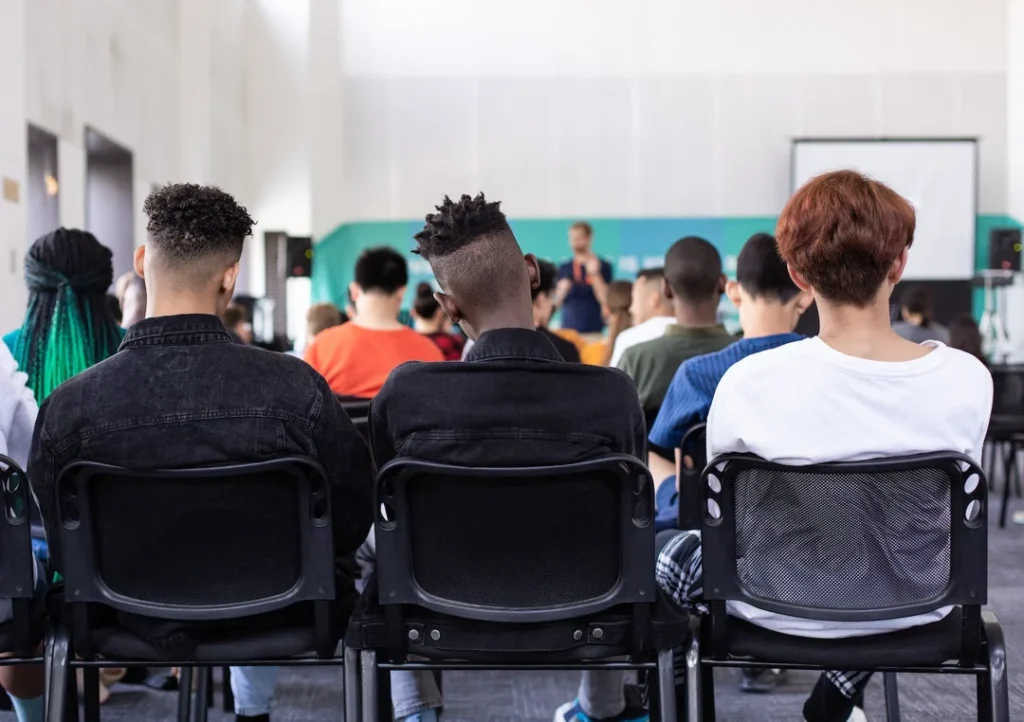Crowd anxiety, or the fear of being in large groups, can be a significant barrier to learning, particularly in traditional educational settings. Understanding and addressing this issue is crucial to ensure all students have equal opportunities to succeed.
Recognizing Crowd Anxiety in Educational Settings
It’s important to acknowledge the signs of crowd anxiety, including excessive worry about being in crowded lectures or events, avoidance of group activities, and physical symptoms such as sweating, trembling, or panic attacks when in crowded spaces.
Strategies for Managing Crowd Anxiety
- Small Group Settings: Opt for classes that offer a lower student-to-teacher ratio. Personal attention in a quiet environment can help ease anxiety.
- Alternative Learning Options: Online courses or independent study programs can provide a quality education with the flexibility to learn at your own pace, away from crowds.
- On-Campus Resources: Utilize the school’s counseling services for support. They can offer personalized strategies and may help arrange accommodations.
- Mindfulness and Relaxation Techniques: Practice mindfulness, deep-breathing exercises, or meditation to manage anxiety symptoms effectively.
- Peer Support Groups: Join or form a study group with a few classmates. Smaller, familiar groups can provide social support without the stress of larger crowds.
Success Stories: Overcoming Crowd Anxiety
Many have found success by combining these strategies with support from educators and peers, demonstrating that crowd anxiety can be managed effectively with the right tools and environment. Here are a couple:

Emma’s Journey Through Crowd Anxiety to Academic Triumph
Emma’s college journey began with a mixture of excitement and trepidation. Bright and curious, she was eager to delve into her major in Environmental Science. However, Emma faced a challenge that went beyond demanding coursework or long nights of study: she struggled with crowd anxiety. The thought of sitting in a packed lecture hall filled her with dread.
Her first semester was tough. She attended her classes but felt isolated and trapped whenever her peers surrounded her. It wasn’t until she reached out to the student counseling services that her journey improved. With the help of her counselor, Emma learned about small group sessions that were part of a pilot program for students who thrived in more intimate learning environments.
Emma decided to give these sessions a try. The change was palpable. In a classroom of ten students as opposed to one hundred, Emma felt her anxiety ebb away. She could focus on the discussions and participate actively; her ideas were heard and appreciated. This was the educational experience she had hoped for, one where she could truly connect with the material and her classmates.
But Emma didn’t stop there. She took up mindfulness meditation, a practice she learned about through a workshop advertised on a campus bulletin board. Every morning, before her classes, she would find a quiet corner in the library to meditate. This practice gave her a sense of peace and a toolkit to calm her nerves whenever she felt anxiety creeping in.
As Emma became more comfortable in her academic environment, her confidence grew. She joined a study group, which met weekly at a local coffee shop. The group was small, but the support was immense. They shared study tips, discussed complex topics, and even tackled group projects. Emma found her tribe, and her fear of crowds slowly diminished.
By the end of her sophomore year, Emma was excelling academically and had become a peer mentor for other students dealing with similar anxieties. She shared her story, struggles, and the strategies that helped her overcome her fears.
Emma’s success story is a testament to her resilience and the power of a supportive educational community. It wasn’t just about managing crowd anxiety but transforming it into a journey of self-discovery and academic excellence. Emma’s experience shows that challenges can become stepping stones to success with the proper support and personal determination.

Alex Overcomes Crowd Anxiety to Lead the Debate Team to Victory
In the bustling corridors of Central High School, Alex walked with his head down, books clutched to his chest, trying to be invisible. His intellect was sharp, and his passion for political science was unmatched, but his crowd anxiety was a shadow that followed him everywhere. The mere thought of the bustling cafeteria or pep rallies made his heart race.
When Alex’s history teacher, Mr. Jacobs, announced the formation of a new debate team, Alex felt a spark of interest. He had always loved to construct arguments and delve deep into political theory, but the prospect of performing in front of a crowd was daunting.
Mr. Jacobs noticed Alex’s interest and approached him after class. Seeing the potential in Alex, he offered him a deal: Alex would help with research and writing, but he wouldn’t have to speak or debate until he felt ready. It was a small step, but it opened a door.
Behind the scenes, Alex thrived. He became the strategist, researcher, and writer—the team’s beating heart. He attended the debates, always in the back, always observing. With each debate, his confidence grew, and the panic that used to consume him began to recede.
Midway through the year, the debate team faced a challenge; their star speaker fell ill on the day of a significant debate. They were a person down, and the possibility of forfeiting was all too real. It was Alex who stepped up. The team needed him, and he couldn’t let his fear hold him back.
Taking the stage, Alex felt his crowd anxiety rise like a tide, but he held onto the podium, took a deep breath, and began to speak. His voice was clear, his arguments compelling, and his presence onstage was undeniable. They won the debate, and Alex discovered a new sense of self.
By senior year, Alex was not only a regular debater but had been elected team captain. His crowd anxiety hadn’t disappeared, but he had learned to manage it, to use the adrenaline it produced to sharpen his focus and performance.
Alex’s success story wasn’t just about winning debates or overcoming anxiety; it was about the journey of growth, pushing past comfort zones, and realizing that sometimes the most significant crowds can lead to the most personal victories.
Conclusion
For those managing crowd anxiety, numerous strategies and resources are available to facilitate a supportive learning experience. It’s about finding the right balance and support system to thrive academically.


